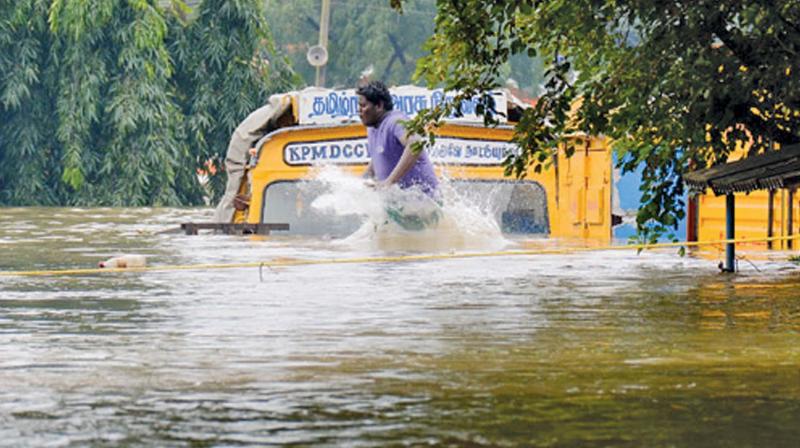Will old umbrella stand up to modern weather events?
Having seen Kerala suffer for an interminable period already this year from floods, it would be wise to understand that things have changed.

It’s the rainy season and the northeast monsoon appears set to come early this year. One would normally keep umbrellas handy and get on with going about the business of the day. You just can’t do this anymore thanks to the ubiquitous social media, parts of which act as scare mongers, reminding us every minute of an impending climate apocalypse. They seem to have taken over from the religious groups that used to specialise in picking the exact date on which Doomsday would fall and send us all packing from planet Earth in one fell swoop.
Having seen Kerala suffer for an interminable period already this year from floods, it would be wise to understand that things have changed. It appears an extreme climate event is only days away these days. There are extreme droughts and raging forest fires on one hand and sinking cities from the rising seas on the other. The phenomenon of extreme climate events has been witnessed in USA, Europe, China, India. Let us not then stop considering all these red alerts even if a few of them fail as the October 7 call has done.
The way we have allowed cities to expand without paying any attention to the consequences on the environment is being blamed for the woes that major urban agglomerations are suffering from every year nowadays. Some cities are sinking from the weight of skyscrapers while others are suffering from overdrawing of groundwater. There are extreme droughts and raging forest fires on one hand and sinking cities from the rising seas on the other.
Fresh water flood events are increasingly destroying the normal lives of people in the metros and a whole load of cities around the world are said to be facing various threats, according to a report prepared by the IPCC for two major global climate talks this month. The reason for Kerala’s urban areas getting hit so badly has been ascribed to poor dam management. The same mismanagement of reservoirs serving city water needs was behind Chennai being flooded in 2015. In effect, the disasters are as much manmade as they are natural events in terms of excessive rainfall.
It must be accepted that there was extraordinary rainfall in a 36-hour period that triggered what was Chennai’s 2015 weather apocalypse, displacing thousands of people, killing a few hundred and causing extensive damage to the lives of many people. Having been soaked already in November 2015 with excessive rainfall far above even the high monthly average for the rainiest month for the northern coastal districts, the city and its surroundings were just not capable of taking in more water from the mother of all storms to it Chennai.
The direct cause of the extensive flooding of the city itself on December 2, 2015 was the belated release of water from the Chembarambakkam lake. The engineers were either waiting for official sanction to release water or they were being so greedy as to wish to store water up to the brim. Doing so even as more rain was forecast as new weather systems kept developing from an active northeast monsoon led to disaster when the floodgates were eventually opened wide and the city was submerged.
Kerala committed the same mistake during the active southwest in August when water engineers were sitting on brimming dams hoping the rain would stop and all the stored water could be put to use for normal drinking and irrigation purposes. The approaching northeast is particularly interesting because the Mettur Dam as well as southern dams are close to capacity and how it is managed may determine whether sudden rushes of floodwater can be avoided. It would seem logical that dams should be kept at around 80 to 90 per cent of capacity rather than full when rain is expected.
The other fear that must be expressed is that an El Nino phenomenon could be building this year. The piece of news only helps remind us that the extreme rainfall of 2015 came in the El Nino period of 2014-16. An early monsoon and any impact of El Nino could bring back memories of the horrors of 2015 in which more than 500 lives were lost, around 18 lakh people displaced and damage could have been anywhere upto half a trillion rupees in Greater Chennai and surroundings alone, according to estimates.
The early warnings about the cyclonic storm said to be brewing right now in the southeastern bay with the attendant red alert for heavy rainfall may have been triggered by the need to be pro-active in the matter of forecasts. The Met office is on its toes and the governments are not far behind in pre-monsoon preparations. In fact, the TN government has done some good work in the water bodies around Chennai, clearing them of encroachments to allow the water to flow and desilting fringes of the lake beds for raising the water storage capacity.
Just like a burnt child dreads the fire, the Met office too may be feeling pressured into making longer term forecasts as well as early and date-specific storm warnings. The October 7 forecast was a massive flop. It appears social media pressures are forcing Met men to speak up quickly in the fear that the warnings must be out sooner, and never mind if weather events don’t follow the wishes of the forecasters. It's better to be safe than sorry and, without doubt, the dictum is being followed by the weather forecasters of the Met and social media blogger variety.
(R. Mohan is the Resident Editor of the Chennai and Tamil Nadu editions of Deccan Chronicle)

